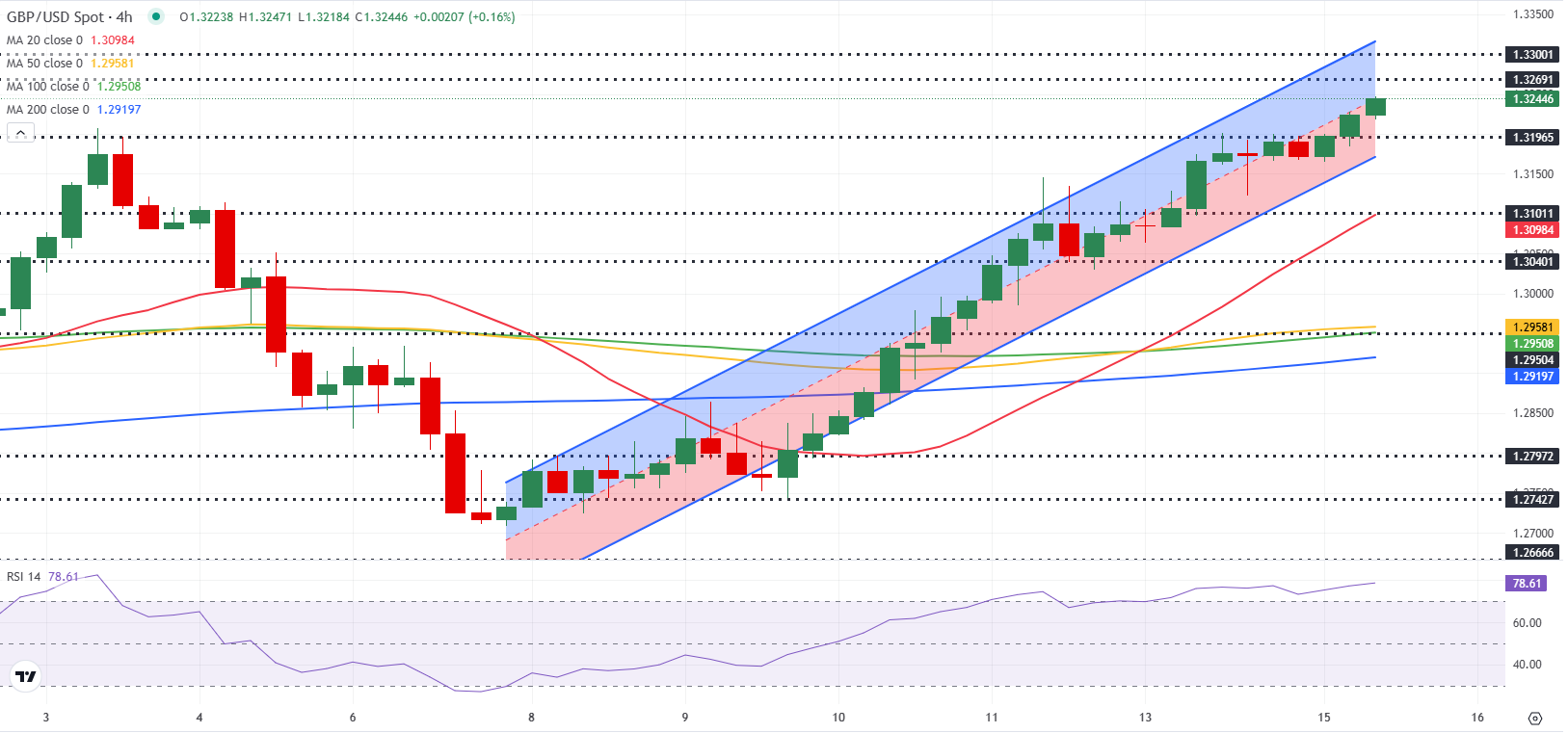- GBP/USD trades at its highest level since early October above 1.3200.
- The ILO Unemployment Rate in the UK held steady at 4.4% in the three months to February.
- The pair's near-term technical outlook shows that conditions remain overbought.
GBP/USD preserves its bullish momentum after posting gains for five consecutive days and trades at a fresh 2025-high near 1.3250 on Tuesday. The pair's technical picture points to overbought conditions.
British Pound PRICE Last 7 days
The table below shows the percentage change of British Pound (GBP) against listed major currencies last 7 days. British Pound was the strongest against the US Dollar.
| USD | EUR | GBP | JPY | CAD | AUD | NZD | CHF | |
|---|---|---|---|---|---|---|---|---|
| USD | -3.83% | -3.87% | -3.40% | -2.72% | -5.71% | -6.32% | -5.27% | |
| EUR | 3.83% | -0.10% | 0.42% | 1.13% | -1.96% | -2.55% | -1.51% | |
| GBP | 3.87% | 0.10% | 0.53% | 1.26% | -1.85% | -2.46% | -1.34% | |
| JPY | 3.40% | -0.42% | -0.53% | 0.70% | -2.37% | -3.04% | -1.88% | |
| CAD | 2.72% | -1.13% | -1.26% | -0.70% | -3.07% | -3.67% | -2.55% | |
| AUD | 5.71% | 1.96% | 1.85% | 2.37% | 3.07% | -0.61% | 0.51% | |
| NZD | 6.32% | 2.55% | 2.46% | 3.04% | 3.67% | 0.61% | 1.15% | |
| CHF | 5.27% | 1.51% | 1.34% | 1.88% | 2.55% | -0.51% | -1.15% |
The heat map shows percentage changes of major currencies against each other. The base currency is picked from the left column, while the quote currency is picked from the top row. For example, if you pick the British Pound from the left column and move along the horizontal line to the US Dollar, the percentage change displayed in the box will represent GBP (base)/USD (quote).
Pound Sterling gathered strength on Tuesday following the UK employment data. In the three months to February, the ILO Unemployment Rate held steady at 4.4%, the Office for National Statistics (ONS) reported. Further details of the publication showed that job vacancies fell below their pre-pandemic levels for the first time in nearly four years.
In the meantime, the improving risk mood further supports GBP/USD in the European session on Tuesday. At the time of press, US stock index futures were rising between 0.2% and 0.3%, while the UK's FTSE 100 Index was up about 1% on the day.
In the second half of the day, the US economic calendar will feature Import Price Index and Export Price Index data for March. Additionally, the Federal Reserve Bank of New York will publish the Empire State Manufacturing Survey for April.
In case risk flows continue to dominate the action in financial markets in the second half of the day, GBP/USD could hold its ground. On the flip side, a rebound in the US Dollar on stronger-than-forecast data releases could open the door for a downward correction in the pair.
GBP/USD Technical Analysis

GBP/USD remains within the ascending regression channel but the Relative Strength Index (RSI) indicator on the 4-hour chart continues to edge higher in the overbought territory above 70, suggesting that GBP/USD could stage a technical correction before the next leg higher.
GBP/USD faces immediate resistance at 1.3250 (mid-point of the ascending channel). In case the pair confirms that level as support, 1.3300 (round level, static level) could be seen as next resistance before 1.3330 (upper limit of the ascending channel).
On the downside, 1.3200 (static level, round level) could be seen as first support ahead of 1.3170 (lower limit of the ascending channel) and 1.3100 (static level, round level).
Pound Sterling FAQs
The Pound Sterling (GBP) is the oldest currency in the world (886 AD) and the official currency of the United Kingdom. It is the fourth most traded unit for foreign exchange (FX) in the world, accounting for 12% of all transactions, averaging $630 billion a day, according to 2022 data. Its key trading pairs are GBP/USD, also known as ‘Cable’, which accounts for 11% of FX, GBP/JPY, or the ‘Dragon’ as it is known by traders (3%), and EUR/GBP (2%). The Pound Sterling is issued by the Bank of England (BoE).
The single most important factor influencing the value of the Pound Sterling is monetary policy decided by the Bank of England. The BoE bases its decisions on whether it has achieved its primary goal of “price stability” – a steady inflation rate of around 2%. Its primary tool for achieving this is the adjustment of interest rates. When inflation is too high, the BoE will try to rein it in by raising interest rates, making it more expensive for people and businesses to access credit. This is generally positive for GBP, as higher interest rates make the UK a more attractive place for global investors to park their money. When inflation falls too low it is a sign economic growth is slowing. In this scenario, the BoE will consider lowering interest rates to cheapen credit so businesses will borrow more to invest in growth-generating projects.
Data releases gauge the health of the economy and can impact the value of the Pound Sterling. Indicators such as GDP, Manufacturing and Services PMIs, and employment can all influence the direction of the GBP. A strong economy is good for Sterling. Not only does it attract more foreign investment but it may encourage the BoE to put up interest rates, which will directly strengthen GBP. Otherwise, if economic data is weak, the Pound Sterling is likely to fall.
Another significant data release for the Pound Sterling is the Trade Balance. This indicator measures the difference between what a country earns from its exports and what it spends on imports over a given period. If a country produces highly sought-after exports, its currency will benefit purely from the extra demand created from foreign buyers seeking to purchase these goods. Therefore, a positive net Trade Balance strengthens a currency and vice versa for a negative balance.
Information on these pages contains forward-looking statements that involve risks and uncertainties. Markets and instruments profiled on this page are for informational purposes only and should not in any way come across as a recommendation to buy or sell in these assets. You should do your own thorough research before making any investment decisions. FXStreet does not in any way guarantee that this information is free from mistakes, errors, or material misstatements. It also does not guarantee that this information is of a timely nature. Investing in Open Markets involves a great deal of risk, including the loss of all or a portion of your investment, as well as emotional distress. All risks, losses and costs associated with investing, including total loss of principal, are your responsibility. The views and opinions expressed in this article are those of the authors and do not necessarily reflect the official policy or position of FXStreet nor its advertisers. The author will not be held responsible for information that is found at the end of links posted on this page.
If not otherwise explicitly mentioned in the body of the article, at the time of writing, the author has no position in any stock mentioned in this article and no business relationship with any company mentioned. The author has not received compensation for writing this article, other than from FXStreet.
FXStreet and the author do not provide personalized recommendations. The author makes no representations as to the accuracy, completeness, or suitability of this information. FXStreet and the author will not be liable for any errors, omissions or any losses, injuries or damages arising from this information and its display or use. Errors and omissions excepted.
The author and FXStreet are not registered investment advisors and nothing in this article is intended to be investment advice.
Recommended Content
Editors’ Picks

EUR/USD extends slide below 1.1350 on renewed USD strength
EUR/USD extends its daily slide and trades below 1.1350 in the American session on Friday. Renewed US Dollar strength on growing optimism about a de-escalation of the US-China trade war makes it difficult for the pair to hold its ground heading into the weekend.

GBP/USD consolidates losses near 1.3300 after UK Retail Sales data
GBP/USD remains under moderate selling pressure near 1.3300 despite the upbeat UK Retail Sales data for March. The pair feels the heat of the solid US Dollar rebound, aided by latest headlines hinting at a softening rhetoric in the ongoing US-China trade conflict.

Gold drops toward $3,250 as market mood improves
Gold turns south following Thursday's rebound and declines toward $3,250 on Friday. The bearish pressure builds up as market mood improves on growing optimism about a de-escalation of the US-China trade conflict after US President Trump hinted at the beginning of negotiations.

Ethereum: Accumulation addresses grab 1.11 million ETH as bullish momentum rises
Ethereum saw a 1% decline on Friday as sellers dominated exchange activity in the past 24 hours. Despite the recent selling, increased inflows into accumulation addresses and declining net taker volume show a gradual return of bullish momentum.

Week ahead: US GDP, inflation and jobs in focus amid tariff mess – BoJ meets
Barrage of US data to shed light on US economy as tariff war heats up. GDP, PCE inflation and nonfarm payrolls reports to headline the week. Bank of Japan to hold rates but may downgrade growth outlook. Eurozone and Australian CPI also on the agenda, Canadians go to the polls.

The Best brokers to trade EUR/USD
SPONSORED Discover the top brokers for trading EUR/USD in 2025. Our list features brokers with competitive spreads, fast execution, and powerful platforms. Whether you're a beginner or an expert, find the right partner to navigate the dynamic Forex market.